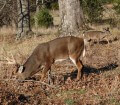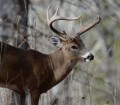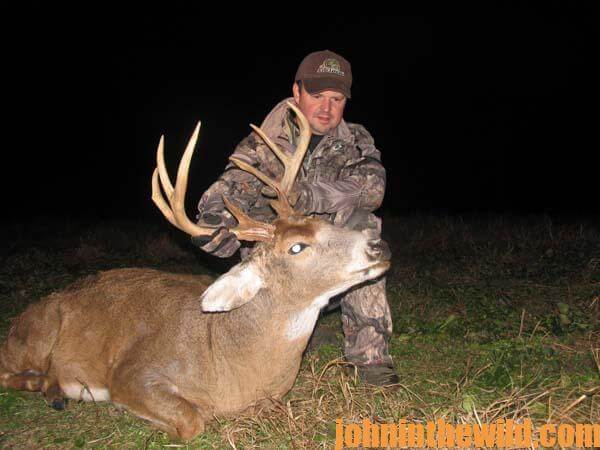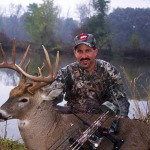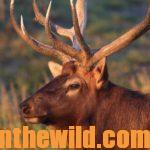John’s Note: The easiest way to bag a buck, which may eat 5-9 pounds of 300+ foods per day, is through his stomach. Learn which foods are what deer like best and also when and why they eat.
 The best source of information is to talk to the state fish and game commission where you hunt. Most states have district biologists responsible for the game in a particular region of each state. This wildlife specialist will know what the deer’s preferred food is during each week of hunting season. He also can tell you how to recognize the preferred food and the types of regions where you can find it. Often hunters waste thousands of hours of scouting that can be saved, if they’ll contact wildlife biologists where they plan to hunt and learn what to scout for before they ever enter the woods.
The best source of information is to talk to the state fish and game commission where you hunt. Most states have district biologists responsible for the game in a particular region of each state. This wildlife specialist will know what the deer’s preferred food is during each week of hunting season. He also can tell you how to recognize the preferred food and the types of regions where you can find it. Often hunters waste thousands of hours of scouting that can be saved, if they’ll contact wildlife biologists where they plan to hunt and learn what to scout for before they ever enter the woods.
Once a hunter learns from the biologist the deer’s preferred food, then he is ready to scout the woods and try to locate that food. When you find that favorite deer food, you should be able to tell from tracks, droppings and signs such as cracked acorn halves, nipped leaves and/or chewed branches if in fact the deer are utilizing that food source where you plan to hunt. Next, search for either a large concentration of that particular food source that will draw the deer into the food or a place that has very little of the deer’s preferred food.
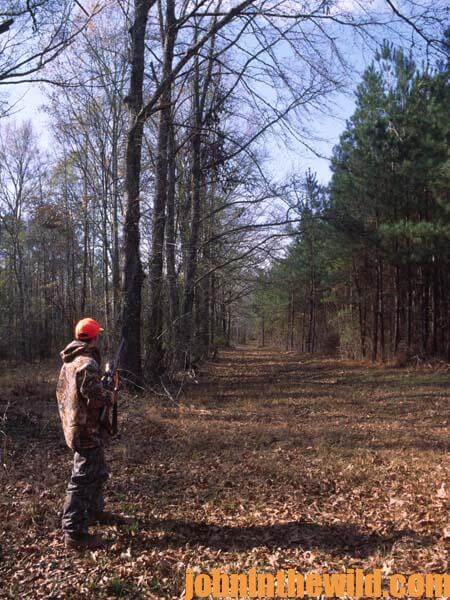 Dr. Keith Causey, longtime avid deer hunter and deer researcher, mentions some other natural happenings that may change a deer’s preferred food. “Of course to be a consistent hunter, you must be intimately aware of the available food on a piece of property that you hunt. You should know where this food is, and when the deer are most likely to go to that particular food source. However, hunters cannot always depend on a particular food source from year to year because of droughts, floods and different natural disasters that may interrupt the growth patterns of a particular food source. Also deer have the ability to determine the best and most-nutritious food available in a given area. For instance, if one year, the soil type in a region is basically poor, and the browse it produces is also poor, deer will gravitate toward a well-fertilized green field that is producing better food than they can find in the woods.”
Dr. Keith Causey, longtime avid deer hunter and deer researcher, mentions some other natural happenings that may change a deer’s preferred food. “Of course to be a consistent hunter, you must be intimately aware of the available food on a piece of property that you hunt. You should know where this food is, and when the deer are most likely to go to that particular food source. However, hunters cannot always depend on a particular food source from year to year because of droughts, floods and different natural disasters that may interrupt the growth patterns of a particular food source. Also deer have the ability to determine the best and most-nutritious food available in a given area. For instance, if one year, the soil type in a region is basically poor, and the browse it produces is also poor, deer will gravitate toward a well-fertilized green field that is producing better food than they can find in the woods.”
One season the acorns failed on the lease that I hunted. So, the traditional hunting pattern had to change. Instead of hunting the acorn flats as we had for many years, the men I hunted with and myself had to find a different food source to hunt over. As we scouted the woods, we discovered that along many of the logging trails, especially the new ones, poke sallet had grown up. And, where we located the poke sallet we found plenty of deer trails running through it. Most of the leaves of the poke sallet were nipped off at the stems. As we continued to watch the poke sallet, we found that whenever there was even a thumb-sized leaf coming out from the stems, the deer nipped those tender greens. On opening day, each of us located different logging roads with poke sallet on them where we took stands. All of us shot at deer, and one took a buck.
 The deer’s feeding habits had changed because of the failing acorn crop. Even though we knew the deer’s preferred food historically was acorns, and where the acorn trees were, if we hadn’t scouted before the season, discovered that the acorn crop had failed and located a new food source, our opening day deer hunt would have been a disaster.
The deer’s feeding habits had changed because of the failing acorn crop. Even though we knew the deer’s preferred food historically was acorns, and where the acorn trees were, if we hadn’t scouted before the season, discovered that the acorn crop had failed and located a new food source, our opening day deer hunt would have been a disaster.
To get John E. Phillips’ eBooks and print books on hunting deer, “How to Hunt and Take Big Buck Deer on Small Properties,” “How to Hunt Deer Up Close: With Bows, Rifles, Muzzleloaders and Crossbows,” “PhD Whitetails: How to Hunt and Take the Smartest Deer on Any Property,” “How to Take Monster Bucks,” “How to Hunt Deer Like a Pro,” and “Bowhunting Deer: Mossy Oak Pros Know Bucks and Bows,” or to prepare venison, “Deer & Fixings,” click here.
For information on making jerky from your deer to provide a protein-rich snack, you can download a free book from https://johninthewild.com/free-books.

